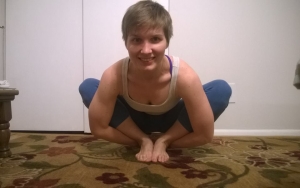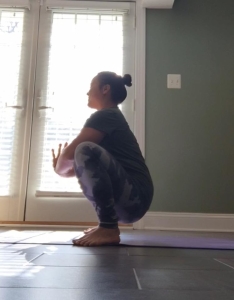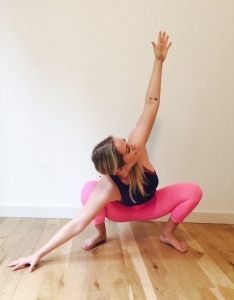Happy Friday yogis! In this week’s #funposefriday we’ll break down the benefits and practice of Malasana, also known as Garland pose or yogic squat.
In India you can see people frequently squatting in Malasana. This posture strengthens the lower back and core, which can be very helpful for maintaining a healthy back.

(check out recent yoga teacher training grad (and rock star), Julie, demonstrating a more traditional version of Malasana above)
In our Western culture you don’t see this as often as you might in other parts of the world. We spend a great deal of time sitting in chairs at work, home and in the car. This causes us to have much less strength and flexibility in our hips, back and legs.
Practicing Garland pose can have an immensely positive effect on our anatomy. It has the power to enable increased mobility in our daily lives.
To get into the Malasana, squat with your feet as close together as possible. Try to keep your heels on the floor. If you are unable to keep heels on the floor, use a blanket or folded mat to support heels.
Move your thighs out wider and lean your torso forward. Lengthen the spine and relax shoulders.
Place your hands in Anjali Mudra (prayer hands), and rest elbows up against your knees. Create resistance by pressing the knees and elbows into each other.

(oh hey, Yogi! (yes, that’s her name) pictured in a gorgeous Malasana above)
Hold for 30 seconds to 1 minute.
You can bring a twist to Malasana by placing right hand on the ground inside or a little bit in front of your right foot and extending the left hand to the ceiling. A bind can then be added by wrapping the right arm around the right leg and reaching the left hand behind your back. Then clasp fingers together or grab onto a strap with both hands. Make sure to do the twist (and bind) on the other side too.
(wow! look at Kathryn Budig’s Malasana twist)
***workshop plug: Kathryn’s coming to DC in April! she’s leading two workshops, a private cooking demo & book signing~ check it out!***
Benefits of Malasana include:
• Strengthens abdominal muscles
• Stretches the groin, thighs, hips, ankles, and back
• Can help improve balance and concentration
• Stimulates digestion
• Beneficial for women who are pregnant in preparing the body for labor
You may want to avoid malasana if you have a lower back or knee injury.
Yoga Journal offers some helpful tips on practicing Garland pose and check out Kathryn’s Malasana sequence to get your ready for Spring.
Enjoy yogis! See you on the mat!

